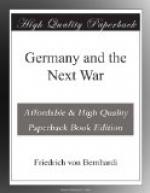The army corps is divided into two divisions, the division into two infantry brigades. All the brigades consist of two regiments. The formation of a reserve makes it very difficult for the commander to fix the centre of gravity of the battle according to circumstances and his own judgment. It is always necessary to break up some body when a reserve has to be formed, and in most cases to reduce the officers of some detachment to inactivity. Of course, a certain centre of gravity for the battle may be obtained by assigning to one part of the troops a wider and to the other a narrower space for deployment. But this procedure in no way replaces a reserve, for it is not always possible, even in the first dispositions for the engagement, to judge where the brunt of the battle will be. That depends largely on the measures taken by the enemy and the course of the battle.
Napoleon’s saying, “Je m’engage et puis je vois," finds its application, though to a lessened extent, even to-day. The division of cavalry brigades into two regiments is simply a traditional institution which has been thoughtlessly perpetuated. It has not been realized that the duties of the cavalry have completely changed, and that brigades of two regiments are, in addition to other disadvantages, too weak to carry these duties out.
This bisecting system, by restricting the freedom of action, contradicts the most generally accepted military principles.
The most natural formation is certainly a tripartition of the units, as is found in an infantry regiment. This system permits the separate divisions to fight near each other, and leaves room for the withdrawal of a reserve, the formation of a detachment, or the employment of the subdivisions in lines (Treffen), for the principle of the wing attack must not be allowed to remain merely a scheme. Finally, it is the best formation for the offensive, since it allows the main body of the troops to be employed at a single point in order to obtain a decisive result there.
A special difficulty in the free handling of the troops is produced by the quite mechanical division of the artillery, who bring into action two kinds of ordnance—cannons and howitzers. These latter can, of course, be used as cannons, but have special functions which are not always required. Their place in the organization, however, is precisely the same as that of the cannons, and it is thus very difficult to employ them as their particular character demands.
The object in the whole of this organization has been to make corps and divisions equal, and if possible superior, to the corresponding formations of the enemy by distributing the batteries proportionately according to numbers among the divisions. This secured, besides, the undeniable advantage of placing the artillery directly under the orders of the commanders of the troops. But, in return, it robbed the commanding General of the last means secured by the organization




